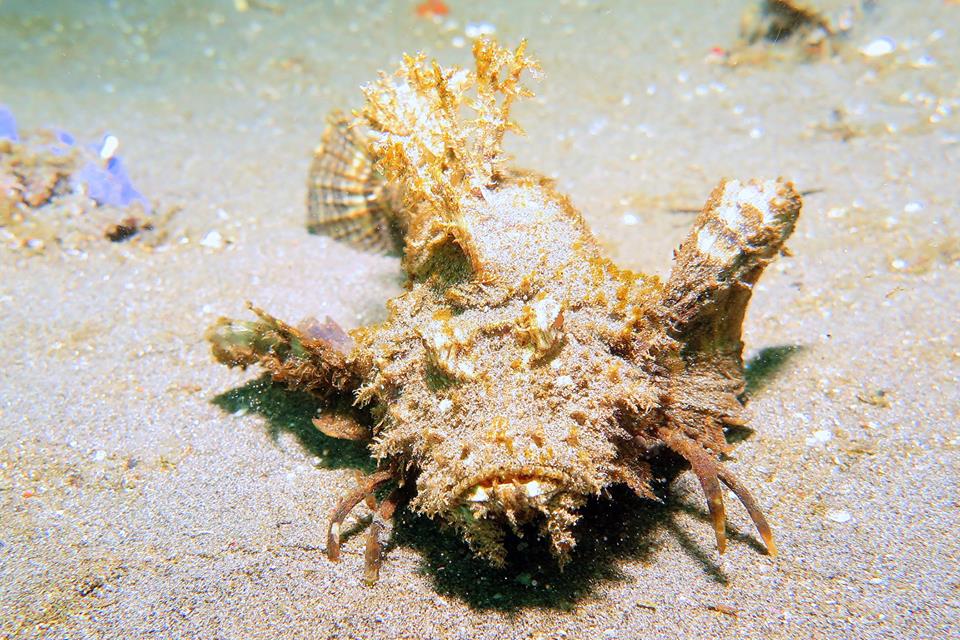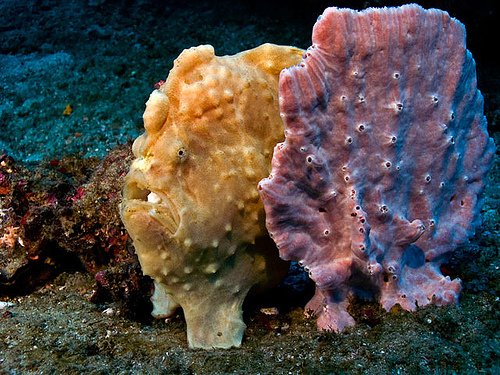Frog fish are a type of fish that belong to the antennariidae family. They are known for their ability to blend into their surroundings.
Frog fish are fascinating creatures with a unique physique that enables them to camouflage perfectly in their surroundings. These bizarre-looking fish are part of the antennariidae family, with over 40 different species found throughout the world’s oceans. They use their broad, flat bodies, and appendages to mimic the appearance of seaweed, rocks, and other marine organisms to remain unnoticed by predators and attract prey.
Despite their small size, frogfish have a formidable presence, and their ability to blend in makes them a must-see for marine enthusiasts. In this article, we’ll discover more about these intriguing creatures, including their unique features, behavior, and habitat, so keep reading to learn more!

Credit: www.baliocean.com
The Camouflage Mechanism
Overview Of The Camouflage Mechanism
Frogfish, scientifically known as antennariidae, is a type of fish that is known for its remarkable camouflage mechanisms. These fishes have a unique ability to mimic their surroundings to blend in seamlessly, making it almost impossible for predators to spot them.
The camouflage mechanism of frogfish is fascinating and has been studied by many marine biologists around the world.
How Frog Fish Camouflage Helps In Its Survival
The camouflage mechanism of frogfish is an adaptation that has helped them survive in their environment. Below are some key points that explain the importance of camouflage for frogfish survival:
- Frogfish have the ability to change their color to match the surrounding environment. This allows them to blend in seamlessly, making them almost invisible to predators.
- The texture of frogfish skin also helps with camouflage. They have small skin projections called dermal spinules, which are similar in texture to corals and sponges, making it difficult for predators to distinguish them from their surroundings.
- Frogfish can also change their body shape to mimic inanimate objects like rocks, algae, and sea plants. This unique ability helps them to avoid detection and predators.
- By camouflaging well, frogfish can also attract their prey. They use their camouflage to lure small fish and shrimp to come closer, before they suddenly strike and capture them.
Frogfish has an amazing camouflage mechanism that helps it survive in its natural environment. Its chameleon-like ability to change its color and shape to blend in with its surroundings is impressive and crucial in protecting it from predators and ensuring its continued existence.
Types Of Frog Fish
Species Of Frog Fish
Frog fish are fascinating creatures that are known for their unique appearance and unusual hunting techniques. But did you know that there are actually over 40 different species of frog fish? Here are a few of the most well-known species:
- Painted frog fish: A colorful fish that can be found in shades of red, orange, yellow, and green. They are often found in shallow waters near coral reefs.
- Hairy frog fish: As its name implies, this fish has long, hair-like appendages that help it blend in with its surroundings. They can be found in a variety of colors, including brown, white, and yellow.
- Gigantic frog fish: The biggest species of frog fish, they can grow up to 30 inches long. They are commonly found in deep waters and are known for their large mouths and impressive camouflage.
Differences In Camouflage And Behavior
One of the most interesting things about frog fish is their ability to blend in with their surroundings. Here are a few key differences in the way different species of frog fish camouflage themselves:
- Color: Some frog fish are brightly colored, while others are more muted. The color of a frog fish often depends on its environment.
- Texture: Frog fish have a unique texture that helps them blend in with their surroundings. Some have bumps or ridges on their skin, while others are more smooth.
- Movement: Frog fish are known for their ability to mimic the movements of other sea creatures. Some species will even sway back and forth like a piece of seaweed.
In addition to their camouflage techniques, different species of frog fish also exhibit unique behaviors. Here are a few examples:
- Hunting technique: While most frog fish are ambush predators that lie in wait for their prey, some species use a lure to attract their prey towards them.
- Reproduction: Frog fish have a unique method of reproduction. Females will lay eggs, which the males will then fertilize and carry around in their mouths until the eggs hatch.
- Defense mechanisms: Some species of frog fish have spines that they can use to defend themselves from predators. Others will inflate themselves with water to appear larger and more intimidating.
Frog fish are a fascinating and diverse group of fish that have evolved to survive in a variety of environments. Whether you’re looking at their unique appearance, hunting techniques, or behavior, there is always something new and interesting to discover about these creatures.
Hunting Strategies
Techniques Used By Frog Fish When Hunting
Frogfish are fascinating creatures that have adapted unique strategies for capturing prey. Here are some hunting techniques employed by these creatures:
- Luring prey: Frogfish are masters of disguise and can camouflage themselves to blend into their surroundings. They lure prey by waggling a fleshy growth called an “illicium” which resembles a small fish or shrimp. Once prey comes close, the frogfish sucks it in with its mouth in less than six milliseconds.
- Using fins to walk: Frogfish are not fast swimmers, and as such, use their modified pectoral fins as “feet” to move around the ocean floor. This helps them hunt prey by slowly and stealthily stalking them.
- Ambushing prey: Frogfish have a short, wide and stocky body that looks like a rock or sponge. They can remain motionless for hours and ambush prey when it comes close.
Examples Of Successful Hunting Stories
Frogfish are known for their successful strategies when it comes to hunting. Here are some successful hunting stories:
- A frogfish was seen blending perfectly into the shape and texture of a coral reef and, as a small crab walked by, the frogfish quickly opened its mouth and swallowed it whole.
- A frogfish was spotted waggling its illicium like a fishing rod and, after a few minutes, a curious shrimp approached and was subsequently captured and consumed.
- A frogfish approached a school of small fish, looking like a rock, and swiftly sucked in several fish at once, before quickly swimming away.
These examples show how the unique hunting techniques of frogfish allow them to be successful predators in their underwater habitat.
Threats To Frog Fish
Frog fish is a fascinating creature that belongs to the anglerfish family. They are well-adapted for their life in the water and have a unique way of catching prey. However, like many species in the marine world, frog fish is facing a host of threats that are endangering its survival.
Habitat Loss And Degradation
Habitat loss and degradation have a considerable impact on the frog fish population. Here are some important points related to habitat loss and degradation:
- The destruction of mangroves and coral reefs affects the habitat of frog fish as they prefer to live in sheltered areas with plenty of soft coral.
- Coastal development and pollution are other factors that pose a threat to frog fish. Marine litter, such as plastic bags, can interfere with the normal behavior of frog fish, and it can even become entangled in them.
Overfishing And Bycatch
Overfishing and bycatch are significant threats to the survival of frog fish. Here are the key points related to overfishing and bycatch:
- Frog fish is often caught accidentally in fishing nets and longlines, which can lead to high levels of mortality.
- The demand for frog fish as a culinary delicacy in some countries has led to unregulated fishing practices that are unsustainable.
Effects Of Climate Change On Frog Fish Population
Climate change is another significant threat to the frog fish population. Here are some of the key points related to climate change:
- Rising temperatures and ocean acidification can have harmful effects on the development, growth, and survival of frog fish.
- Changes in ocean currents and sea level have a direct impact on the distribution and abundance of frog fish.
The threats facing frog fish are complex and interrelated. If we want to preserve this unique species, we need to take a comprehensive approach that considers the impact of habitat loss, overfishing, and climate change. It requires a joint effort to promote sustainable fishing practices, reduce plastic waste, and mitigate the effects of climate change.
Frequently Asked Questions On Frog Fish
What Is A Frog Fish?
Frogfish are small, stocky, and camouflaged marine fish. They are found in shallow and tropical waters worldwide. Frogfish are not strong swimmers; instead, they move by “walking” on their modified fins or by hopping on the sea bottom. They are carnivorous and catch their prey by using an ambush technique.
What Do Frogfish Eat?
Frogfish feed on crustaceans, small fish, and even other frogfish. They use a “lure” to attract their prey; the lure can be in the form of a worm, shrimp, or fish, and is held over the fish’s mouth by a “fishing” pole-like appendage on the fish’s head.
Once the prey is close enough, the frogfish will snap them up with lightning speed.
Can I Keep A Frogfish As A Pet?
Yes, it is possible to keep a frogfish as a pet. However, they require specialized care and an aquarium with certain specifications. Frogfish are known to be aggressive towards other fish, so they should be kept alone or with other large and aggressive fish.
It is also recommended to maintain a well-established aquarium with live rock, which will provide the fish with hiding places.
How Long Do Frogfish Live?
Frogfish can live up to 15 years in the wild, although some may live longer in captivity with proper care. Their lifespan depends on various factors such as food, habitat, and environmental conditions.
How Do Frogfish Reproduce?
Frogfish lay eggs, which hatch into larvae that float in open water. The larvae then develop into miniature versions of the adult, and settle onto the seabed. Frogfish have a unique mating behavior where the male mounts the female, and they release their eggs and sperm simultaneously into the water, where fertilization occurs.
The fertilized eggs then develop into larvae.
Where Can I Find Frogfish?
Frogfish can be found in shallow and tropical waters worldwide, primarily in the indo-pacific region. They are often found hiding on rocks, coral, or under objects on the sea bottom. Scuba divers and snorkelers can look for them on the reef, but they are hard to spot due to their excellent camouflaging ability.
Conclusion
The unusual appearance and unique characteristics of the frogfish have captured the attention of scuba divers and marine enthusiasts worldwide. These fascinating creatures are masters of disguise, able to blend almost seamlessly into their surroundings to avoid detection or ambush unsuspecting prey.
Despite their somewhat unappealing appearance, frogfish are a vital part of the marine ecosystem, playing a crucial role in maintaining balance and biodiversity. With their incredible adaptability and unique hunting technique, frogfish offer a truly unforgettable underwater experience for those lucky enough to encounter them.
Whether viewed in the wild or appreciated through stunning underwater photography, the frogfish is a remarkable species that continues to fascinate and capture the imaginations of those who venture beneath the waves. Its vital to protect this species and maintain the marine ecosystem to enjoy such diversity and beauty.
